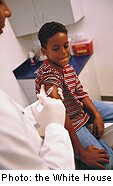 |
 |
 |
||
    |
||||
|
||||

More Low-Income Kids Are Getting Vaccinated
The immunization gap between wealthier, poorer children is shrinking, study finds|
|
HealthDay
Monday, May 4, 2009
 MONDAY, May 4 (HealthDay News) -- The good news from a new study is that more American children from low-income families are getting the vaccines they need.
MONDAY, May 4 (HealthDay News) -- The good news from a new study is that more American children from low-income families are getting the vaccines they need.
The bad news is that there's still a wide disparity between low- and high-income children when it comes to protection against diphtheria, tetanus and whooping cough (pertussis), via the combo DTaP vaccine, the researchers say.
In a study published in the May issue of the Archives of Pediatric & Adolescent Medicine, researchers reported that timely vaccinations were up for low-income children for all vaccines, except the Haemophilus-influenzae (Hib) vaccine, where levels remained unchanged.
When the researchers looked at the disparity between low- and high-income children, they found the vaccination gap was closing for three vaccines, but was increasing for the three-in-one DTaP vaccine.
"We've made progress, but we still have a long ways to go," Dr. Mark Diamond, a pediatrician at Children's Hospital of Pittsburgh, said of the study.
"Further progress in timely vaccination may be achieved by improving health care providers' reminder/recall systems, implementing educational interventions that address barriers to vaccination, and increasing parents' awareness of the Vaccines for Children Program," wrote the study's authors.
The Vaccines for Children Program (VCP) was established in 1994 to provide free or low-cost vaccines to low-income children. The program was developed after a resurgence of measles was observed between 1989 and 1991. Measles cases disproportionately affected inner-city, preschool-aged, and minority children, experts noted.
The current study was designed to assess whether or not most 19- to 35-month-old low-income children were receiving timely vaccinations. Low-income households were defined as those living 133 percent below the poverty level and high-income households were those living 400 percent or more above the federal poverty level. The federal poverty level changes depending on family size, but as an example, in 1997, the federal poverty level for a family of 5 was $24,744, according to the study.
The study included more than 232,000 youngsters living in low-income households between 1995 and 2007.
The researchers found that timely immunizations were up for every vaccine type, except for Hib. Levels of immunization in low-income children remained unchanged for the Hib vaccine.
The gap in vaccinations between kids from low- and high-income families shrank for the measles-mumps-rubella (MMR) vaccine, hepatitis B immunization, and the chickenpox (varicella) vaccine. Differences between high- and low-income children's vaccination rates did not budge for the polio vaccine, and actually widened by 0.4 percent for the DTaP vaccine, according to the study.
"On the whole, low-income children are catching up," said Dr. Peter Belamarich, a pediatrician at Children's Hospital of Montefiore in New York City. "There's more work to do, but we're having success on the whole in increasing vaccination rates," he said.
Nevertheless, "parents should actively ask about their child's immunization status when they're in the doctor's office, and they should permit the pediatrician to administer whichever vaccines are due. There's no upper limit on the number of vaccinations a child can have in one visit," explained Belamarich.
Diamond said that providing access is key to improving these rates even further, and that education has to follow the access. If people don't realize that low- or no-cost vaccines are available, immunization rates won't go up, he pointed out.
"We need to ensure access and professional cooperation, and provide more outreach to the community," said Diamond.
"Vaccines are an important step to providing a healthy environment for your child," he noted.
Two other studies in the same issue of the pediatric journal also examined vaccine-related issues. One found that international records of immunizations for children adopted from other countries aren't reliable indicators of whether or not children have been vaccinated.
For example, immunity in some of the children against certain types of polio was only around 50 percent. The study included children adopted from China, Russia and Guatemala. Children from China were the most likely to be lacking protective immunity. The researchers suggested that children adopted from other countries should be tested to assess their protective immunity, and if necessary, be revaccinated.
A third study looked at the order in which two immunizations are given, to see if there was any difference in babies' pain levels. Pain levels were assessed using a visual pain scale and whether or not the baby cried.
The Canadian researchers found that pain was reduced when the pneumococcal-conjugate vaccine (PCV) was given after the diphtheria, polio, tetanus, pertussis and Haemophilus-influenzae type b (DPTaP-Hib) vaccine.
HealthDay
Copyright (c) 2009 ScoutNews, LLC. All rights reserved.
Related News:
More News on this Date
Related MedlinePlus Pages:
| Home | Health Topics | Drugs & Supplements | Encyclopedia | Dictionary | News | Directories | Other Resources | |
| Disclaimers | Copyright | Privacy | Accessibility | Quality Guidelines U.S. National Library of Medicine, 8600 Rockville Pike, Bethesda, MD 20894 National Institutes of Health | Department of Health & Human Services |
Date last updated: 05 May 2009 |
